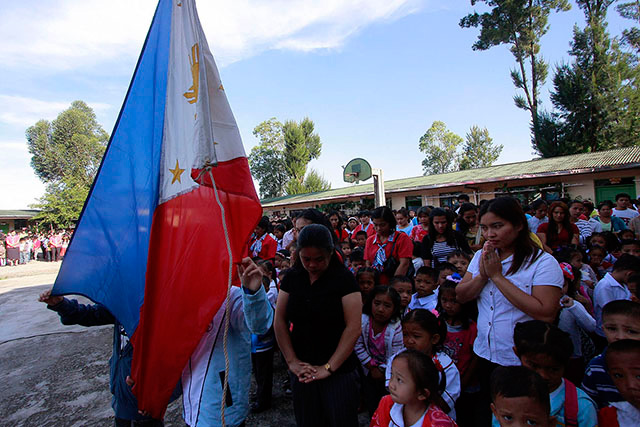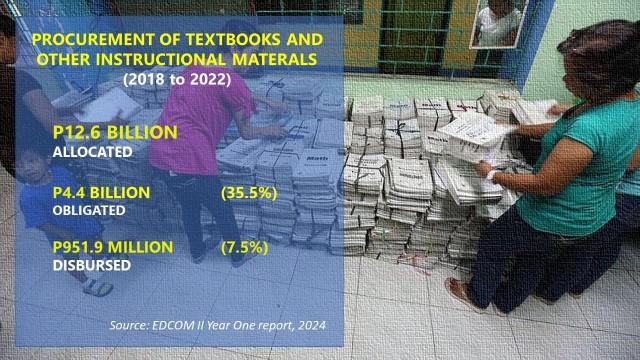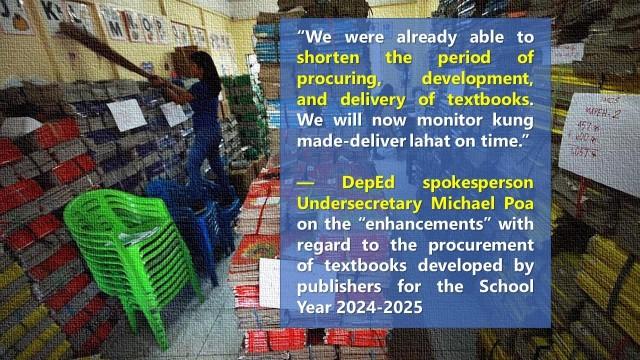The Cost of Miseducation: Handling PH education's purse

After looking at the lack of investment in Philippine education, the second part of this GMA News Online series focuses on cases when funding for education was made available but not maximized, perhaps sometimes squandered, much to the detriment of Filipino students and teachers.
This is The Cost of Miseducation.
SECOND OF THREE PARTS
To address the “learning crisis” in Philippine education, knowing how to get more bang for buck is just as important as having more money in the purse.
In the first part of this series, Vietnam’s success was cited: it spent slightly more per student than the Philippines, but Vietnamese learners outscored Filipino counterparts by over 100 points in reading, math, and science in the 2022 Programme for International Student Assessment (PISA). Moreover, Vietnam spent just over one-fourth of Malaysia’s expenditure.
Over the past years, what were the issues cited by the Second Congressional Commission on Education (EDCOM II) that could have been avoided with proper spending? One of these directly affects students and teachers alike: delays in textbook procurement and distribution.
The commission found that for the past decade, even if the budget was available, textbooks were not being procured on time. Essential educational materials were not on students’ hands when needed, hindering effective learning and teaching.
READ: FIRST OF THREE PARTS
The Cost of Miseducation: Lack of investment in PH education sector
READ: LAST OF THREE PARTS
The Cost of Miseducation: Task at hand for PH education
Citing data by DepEd’s Bureau of Learning Resources, the commission said that since 2012–when the K to 12 program was implemented–up to 2023, only 27 textbooks had been procured for Grade 1 to Grade 10.
Specifically, only Grades 5 and 6 had their textbooks completely procured for the following subjects: Araling Panlipunan, English, Edukasyong Pantahanan at Pangkabuhayan (EPP), Technology and Livelihood Education (TLE), Edukasyon sa Pagpapakatao (ESP), Filipino, Math, Music and Arts, Physical Education (PE) and Health, and Science.
Grades 4, 8, 9, and 10 had textbooks procured only for one or few subjects, while Grades 1, 2, 3, and 7 had none at all.
How were the public funds spent? From 2018 to 2022 alone, the EDCOM II said that a total of P12.6 billion was allocated to these and other instructional materials.
However, of this amount, only P4.4 billion (35.3%) was obligated, and P951.9 million (7.5%) was disbursed.

Back to school
Given that the phased implementation of the revised K-10 curriculum is already set to begin this incoming School Year 2024-2025, the Alliance of Concerned Teachers (ACT) raised the alarm on how these delays in textbook procurement would pose a problem once classes start on July 29.
“Doon pa lamang sa K-12, talagang matindi na ‘yung karanasan ng mga teacher. Hindi lamang usapin ng delay, hindi lamang usapin ng mga mali-mali or errors, talagang kulang at walang wala,” ACT chairperson Vladimer Quetua said.
(The teachers suffered so much even during the old K-12 curriculum. It's not just a matter of delay, and mistakes or errors, there really is a lack of textbooks.)
Senator Sherwin Gatchalian, chairman of the Senate Committee on Basic Education, had also recognized such delays, underscoring the need to improve the logistics given that DepEd is reliant on the private sector when it comes to printing and distributing textbooks.
The senator, who is also a co-chairperson of EDCOM II, shared his aspiration of having all school children acquire their own textbooks–a goal, which he admitted was still difficult to reach because of budget restrictions.
“That's my dream for our country, for our students–no one will return their textbooks and workbooks, no one will share their textbooks and workbooks. Everyone, all students will get their workbooks and textbooks for free, they can bring it home, they can write on it and that's theirs [already],” Gatchalian said.
“We're not yet in that stage. But that's my goal. Hopefully one day, we will achieve that,” the senator said.
Buy books instead
The EDCOM II, in its report, suggested that DepEd consider procuring textbooks that are already available in the market rather than having publishers develop new ones.
The commission also called on DepEd to review its strategy for ensuring timely textbook procurement for the upcoming school year, where the MATATAG K-10 curriculum will already be implemented in Kinder, Grade 1, Grade 4, and Grade 7.
For his part, DepEd spokesperson Undersecretary Michael Poa said the suggestion can be studied and explored further with the National Book Development Board (NBDB), an agency under the DepEd tasked to, among others, promote the growth of a globally competitive book publishing industry.
Meanwhile, the DepEd has already made “enhancements” with regard to procurement of textbooks developed by publishers in preparation for the next school year.
The department’s procurement process, Poa said, now allows publishers to “bundle” the development, printing, and delivery of the textbooks for faster transactions.
“Dito pa lang sa first semester ng 2024, ay nakapag-procure na tayo ng textbooks. I think there are only a few lots left that are for evaluation… Nagsimula na nga mag-deliver ‘yung mga first tranches natin ng textbooks,” Poa said, adding that consultations were made with publishers regarding the process.
(We’ve already procured textbooks during the first semester of the year. I think there are only a few lots left that are for evaluation… We’ve already started delivering the first tranches of textbooks.)
“We were already able to shorten the period of procuring, development, and delivery of textbooks. We will now monitor kung made-deliver lahat on time (We will now monitor if all of them will get delivered on time),” he added.

Educating the poor
Aside from textbooks, the EDCOM II also noticed a discrepancy in distribution of the Tertiary Education Subsidy (TES)–a grant-in aid program that supports the full or partial cost of tertiary education of Filipino undergraduate students enrolled in private higher education institutions (HEIs), State Universities and Colleges (SUCs), or Local Universities and Colleges (LUCs).
The TES is based on a prioritization system set by the Unified Student Financial Assistance System for Tertiary Education Act (UniFAST) Board, according to Republic Act 10931 or the Universal Access to Quality Tertiary Education Act.
Supposedly, it should be given only to students who are:
- Part of households included in the Listahanan 2.0, ranked according to the estimated per capita household income; and who are
- Not part of the Listahanan 2.0, ranked according to estimated per capita household income based on submitted documentation of proof of income to be determined by the UniFAST Board
The Listahanan 2.0 is also known as the National Household Targeting System for Poverty Reduction, created by the Department of Social Welfare and Development (DSWD) to identify who and where the poor are in the country.
Despite the defined criteria for the program, the commission’s analysis showed that the number of TES grantees identified as the poorest of the poor under the Listahanan 2.0 and the 4Ps (Pantawid Pamilyang Pilipino Program) diminished, and their proportion within the total distribution also decreased.
“In 2018, 204,234 students in this category received TES, accounting for 74.24%. This number sharply declined to 69,887, making up only 30.74% of the total by 2022,” the report read.

Prioritizing the ones in need
Gatchalian said that the declining proportion of poor grantees was not only specific to TES, but also in other financial assistance programs of DepEd like the Education Service Contracting (ESC) and the Senior High School Voucher Program (SHSVP).
The lawmaker stressed the importance of practicing equity in order for the poor to keep up or to at least be at par with the other students in the education system.
“During our hearing, DepEd admitted that the poor and deserving are not being prioritized. And that's contrary to our principle of equity wherein we prioritize the poor but deserving students and then if we have excess funds, we prioritize the other types of students,” he said.
In a Senate hearing in March, it was disclosed that there were over 19,000 "ghost students" or undocumented beneficiaries of the SHSVP—a program which provides subsidies in the form of vouchers to qualified SHS learners in participating schools.
Gatchalian also said that around P8 billion worth of educational assistance, supposedly for underprivileged learners, was spent annually for “non-poor” students under the ESC—a program which contracts certified private junior high schools to allocate slots for students to study there, instead of public schools.
Support for private schools
To avoid these kinds of issues, Quetua suggested that the funding for financial assistance for students studying in private HEIs, SUCs, and LUCs just be realigned to improve the public schools offering basic education.
“Dapat ang gawin na lang ng government, imbes na ilaan na lamang ito sa private, ipagawa na lang ng mga classrooms at mag-hire na lang teachers sa basic public education,” he said.
(Instead of allocating a budget for the private sector, let’s just use the money to build more classrooms and hire more teachers in basic public education.)
However, cutting down on support for private institutions does not sit well with the Coordinating Council of Private Educational Associations of the Philippines (COCOPEA), the umbrella organization of private educational organizations in the country.
COCOPEA chairperson Fr. Albert Delvo said Queta’s statement does “not respect, neither does it advance nor operationalize” public-private complementarity and partnership in the Philippine education system.
He argued that supporting private education is even “more cost-efficient and outcome-effective in elevating the quality of education in the country.”
The ACT chair’s remark and recommendation, Delvo said, “do not reflect proper recognition that private educational institutions, [both] basic and tertiary, are brilliantly delivering the same public good which is education, the same public good that public schools give.”
COCOPEA had lamented decreasing enrollment numbers in private institutions as more students transfer to public schools, where tuition is subsidized by the state.
READ: FIRST OF THREE PARTS
The Cost of Miseducation: Lack of investment in PH education sector
READ: LAST OF THREE PARTS
The Cost of Miseducation: Task at hand for PH education
Deserving students
For DepEd’s part, Poa had admitted that existing guidelines for these programs still need to be strengthened to ensure that the beneficiaries really come from underprivileged families, particularly those with P20,000 or less monthly family income.
Thus, starting SY 2024-2025, he said ESC grantees or applicants already need to show proof of their family income and upload it in the system of the ESC-participating schools.
“We need to really ensure that there are established controls para masigurado natin na natutulungan natin 'yung pinakanangangailangan. That's why this year meron tayong second layer na gagawin dito,” Poa said.
(We really need to ensure that there are established controls so that we can make sure that we are helping those who need it the most. That's why this year we have a second layer of screening to implement.)
“Ang gusto nating mangyari is mag-attach na rin talaga sila, i-upload nila ‘yung kanilang income para makita talaga natin… at magkaroon tayo ng prioritization kung sino talaga dapat ang mabigyan dahil nga with the limited slots,” he added.
(What we want to happen is for grantees to upload proof of their family income so we can really see and give prioritization to those who really need it, given the limited slots.)
As to the voucher program, he said the DepEd’s Government Assistance and Subsidies Office is set to release updated guidelines by October 2024.
Scrutinizing the results
With these issues, and all others found or not found by the EDCOM II, Gatchalian said wise spending should come into play.
As the government prepares for the budget deliberations for fiscal year 2025, he said that the “outputs” of agencies like DepEd will be examined to see how well they are doing in terms of spending the money that was given to them.
“The moment we start the budget deliberation, we will look at how allocations are being done, what programs are being funded. We will scrutinize very carefully the outputs rather than the inputs,” he said.
The DepEd is confident with how it used its budget over the past few years, noting an approximate 95% utilization for 2022 and 2023.
Poa said that DepEd has a 95.05% budget utilization in 2022, and 94.87% in 2023. So far this year, he said that the agency is still at 35% utilization as classes have yet to start by end-July.
“We are on track to meet the 95%, but of course, we want to also try to even improve on the 95% average in terms of budget utilization for the past two years,” Poa said. — VDV, GMA Integrated News




